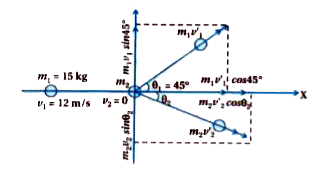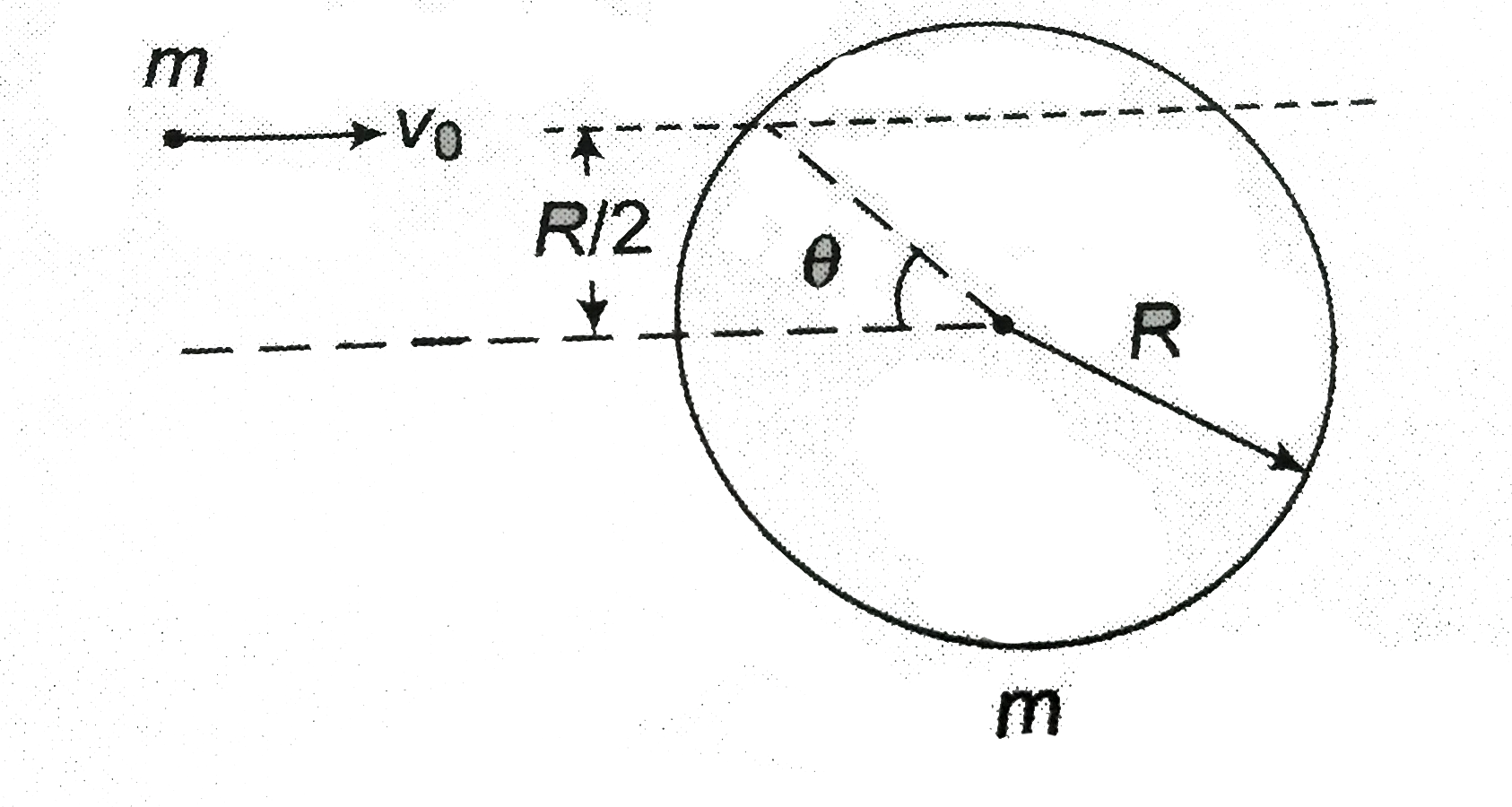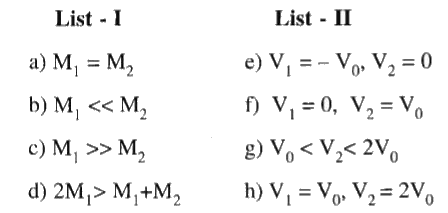A sphere of steel of mass 1 kg moving with a velocity of 12m/s ,along X-axis collides elastically with a stationary sphere after the collision is 8 m/s and is moving at an angle of 45∘ with X -axis , find the magnitude and direction of the second sphere after the collision .
 Solution in Gujrati
Solution in Gujrati
Momentum is conserved in collision ,
∴M1→v1+m2→v2=m1→v1+m2→v2
Taking X - components and →v2=0
m1v1=m1v1cosθ1+m2v2cosθ2
∴180=120×1√2+20v2cosθ2
∴180=120×1√2+20v2cosθ2
∴9−3√2=v2cosθ2 ......(1)
Taking Y - components ,
0=m1v1sinθ1−m2v2sinθ2
∴0=15×8×sin45∘−20v2sinθ2
∴0=15×8×sin45∘−20v2sinθ2
∴0=120×1√2−20v2sinθ2
∴0=3√2−v2sinθ2
∴4.2425=v2sinθ2 ........(2)
Taking the ratio of equation (2) and (1) ,
∴v2sinθ2v2cosθ2=4.24254.758
∴tanθ2=0.8916
∴tanθ2=0.8916
∴θ2=tan−1(0.8916)
∴θ2=41∘43
∴v2sin(41∘43)=4.2425
∴v2=4.2425sin(41∘43)=4.24250.6654
∴v2=6.37ms−1
Topper's Solved these Questions
- BOOK - KUMAR PRAKASHANCHAPTER - WORK, ENERGY AND POWER EXERCISE - SECTION - C Objective Questions (VSQs)52videos
WORK, ENERGY AND POWER
- BOOK - KUMAR PRAKASHANCHAPTER - WORK, ENERGY AND POWER EXERCISE - SECTION - D NCERT Exemplar Solutions (Multiple Choice Questions)21videos
WORK, ENERGY AND POWER
- BOOK - KUMAR PRAKASHANCHAPTER - WORK, ENERGY AND POWER EXERCISE - SECTION - B Numericals (Numerical From Textual Exercise)42videos
WORK, ENERGY AND POWER
- BOOK - KUMAR PRAKASHANCHAPTER - WAVESEXERCISE - SECTION-F (Questions From Module) (Sample questions for preparation of competitive exams)23videos
WAVES
Similar Questions
If →A=2ˆi−2ˆjand→B=2ˆk then →A.→B……
View SolutionAn electron and a proton are moving under the influence of mutual forces . In calculating the change in the kinetic energy of the system during motion , one ignores the magnetic force of one on another . This is , because
View SolutionThe sign of work done by a force on a body is important to understand .State carefully if the following quantities are positive or negative :
(a) work done by a man in lifting a bucket out of a well by means of a rope tied to the bucket .
(b) work done by gravitational force in the above case ,
(c ) work done by friction on a body siding down an inclined plane ,
(d ) workdone by an applied force on a body moving on a rough horizontal plane woth uniform velocity .
(d) work done by the resistive force of air on a vibrating pendulum in bringing it to rest .06:11View SolutionIn a standing wave formed by two atoms separated by 1.21Å, there are 3 nodes and 2 antinodes. Find its wavelength.
04:29View SolutionA particle of mass m moving with velocity v0 collides with sphere of same mass at rest , as shown. If the surface of contact is smooth and the collision is elastic, find the velocities of particle and sphere after the collision.
 05:04View Solution
05:04View SolutionA sphere collides with another sphere of identical mass. After collision, the two spheres move. The collision is inelastic. Then the angle between the directions of the two spheres is
04:57View SolutionA sphere of mass m moves with a velocity 2v and collides inelastically with another identical sphere of mass m. After collision the first mass moves with velocity v in a direction perpendicular to the initial direction of motion . Find the speed of the second sphere after collision .
04:00View Solutionक्रमश: m1 तथा m2 द्रव्यमान के दो गोले A तथा B आपस में टकराते है । प्रारम्भ में A स्थिर तथा B वेग v से X-अक्ष के अनुदिश गतिमान है। टक्कर के पश्चात B का वेग v2 उसके प्रारम्भिक वेग की लंबवत दिशा में हो जाता है। टक्कर के पश्चात द्रव्यमान A की गति की दिशा होगी
04:57View Solutionm द्रव्यमान का एक गोला नियत वेग से गतिशील है तथा समान द्रव्यमान के अन्य स्थिर गोले पर टकराता है। यदि e प्रत्यास्थता गुणांक है, तब संघट्ट के बाद गोले के वेग का अनुपात होगा
View SolutionA sphere of mass 2 kg moving with a velocity collides elastically with another sphere which is at rest. If after the collision, the first sphere moves in the same direction with its velocity reduced to one third of its initial velocity, find the mass of the second sphere.
05:56View SolutionA sphere of mass 0.3 kg moving with a velocity of 4 m/s collides with another sphere of mass 0.5 kg which is at rest. Assuming the collision to be elastic, their velocities after the impact are
04:00View SolutionA sphere of mass 2 kg moving with a velocity collides elastically with another sphere which is at rest. If after the collision, the first sphere moves in the same direction with its velocity reduced to one third of its initial velocity, find the mass of the second sphere.
View SolutionA sphere of mass 2 kg moving with a velocity of 40 ms^(-1) hits another sphere which is at rest. After the collision, they move together with a velocity of 25 ms^(-1) in one direction. Find the mass of the second sphere.
View SolutionA sphere of mass M,, moving with a velocity V0 collides head on with a stationary sphere of mass M. The collision is elastic. V1 and V2 are respectively their velocities immediately after collision.
 View Solution
View SolutionA sphere of mass 0.3 kg moving with a velocity of 4 m/s collides with another sphere of mass 0.5 kg which is at rest. Assuming the collision to be elastic, their velocities after the impact are
View Solution

